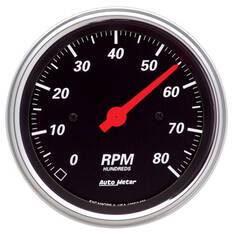Exactly How a Tachometer Assists Screen Engine Health and Performance
Exactly How a Tachometer Assists Screen Engine Health and Performance
Blog Article
Discovering the Functions and Advantages of a Tachometer: A Comprehensive Overview for Car Lovers
From giving real-time information on engine speed to aiding in maximizing gear shifts, the tachometer serves as even more than just a dial on the dashboard. Its complex features not only enhance driving experience but additionally play a crucial function in maintaining engine health and effectiveness.
Comprehending the Basics of a Tachometer
In the realm of vehicle instrumentation, understanding the fundamentals of a tachometer is crucial for any kind of car fanatic looking to dive right into the complexities of engine performance tracking. A tachometer, usually presented on the dashboard of a car, gauges the engine's revolutions per minute (RPM)
Tachometers commonly have a scale noted in changes per minute, with a redline indicating the maximum rate at which the engine can safely operate (tachometer). This info is essential for avoiding engine damage and maximizing equipment shifting for hands-on transmissions. Furthermore, tachometers can aid in diagnosing engine issues such as misfires or a failing ignition system by detecting uneven RPM analyses
Importance of Keeping Track Of Engine Speed

The engine rate, gauged in revolutions per min (RPM), suggests how quick the engine's crankshaft is rotating. Keeping an eye on engine speed is specifically critical during equipment shifts, as it assists chauffeurs identify the ideal time to change gears for smooth velocity and efficient fuel intake.
Furthermore, tracking engine rate can also supply valuable insights right into the general health of the car. Uncommon variations in RPM may suggest problems such as a clogged up air filter, fuel system issues, or perhaps engine misfires. By spotting these abnormalities beforehand through the tachometer readings, motorists can resolve potential problems promptly, stopping extra severe damage and costly repair work down the line. Generally, monitoring engine speed with a tachometer is a fundamental practice that can enhance driving performance, prolong engine life, and guarantee a safer and much more pleasurable driving experience.
Enhancing Performance Through Equipment Shifts
Proper equipment shifting makes certain that the engine operates within its optimum power band, permitting for smooth acceleration and improved fuel economy. When moving gears, it is vital to pay interest to the engine rate suggested on the tachometer.

To achieve peak performance with gear changes, vehicle drivers ought to exercise smooth and prompt transitions between gears, matching engine speed with road speed to harness the complete potential of their car's powertrain.
Maximizing Effectiveness With a Tachometer
Understanding the art of equipment changing in high-performance cars not just improves driving experience but likewise plays a critical duty pop over here in making best use of efficiency with a tachometer. tachometer. By paying very close attention to the tachometer analyses, chauffeurs can optimize their gear changes to run within the engine's most reliable range. When increasing, shifting gears at the right RPM suggested by the tachometer can avoid the engine from exhausting or underperforming, bring about boosted fuel effectiveness and total performance
Additionally, a tachometer helps motorists stay clear of unneeded revving, which not only loses fuel but also puts unneeded stress on the engine. Regularly checking the tachometer while driving enables smoother equipment shifts, decreasing More Info deterioration on the transmission system in time.

Advanced Tips for Tachometer Usage
To dig into innovative pointers for tachometer application, consider incorporating the use of shift lights. Change lights are aesthetic indications that light up when it's time to move gears based on engine transformations per min (RPM), enabling for seamless equipment adjustments without regularly checking the tachometer. By fine-tuning change factors and setting cautioning thresholds, vehicle drivers can maximize acceleration and engine performance while minimizing the risk of over-revving.
Verdict
Finally, the tachometer acts as a vital tool for vehicle enthusiasts to keep an eye on engine speed, boost efficiency through equipment shifts, and make best use of performance. By recognizing the functions and advantages of a tachometer, motorists can optimize their driving experience and lengthen the life expectancy of their vehicle. Making use of innovative suggestions for tachometer utilization can additionally improve driving abilities and general efficiency when traveling.
Report this page